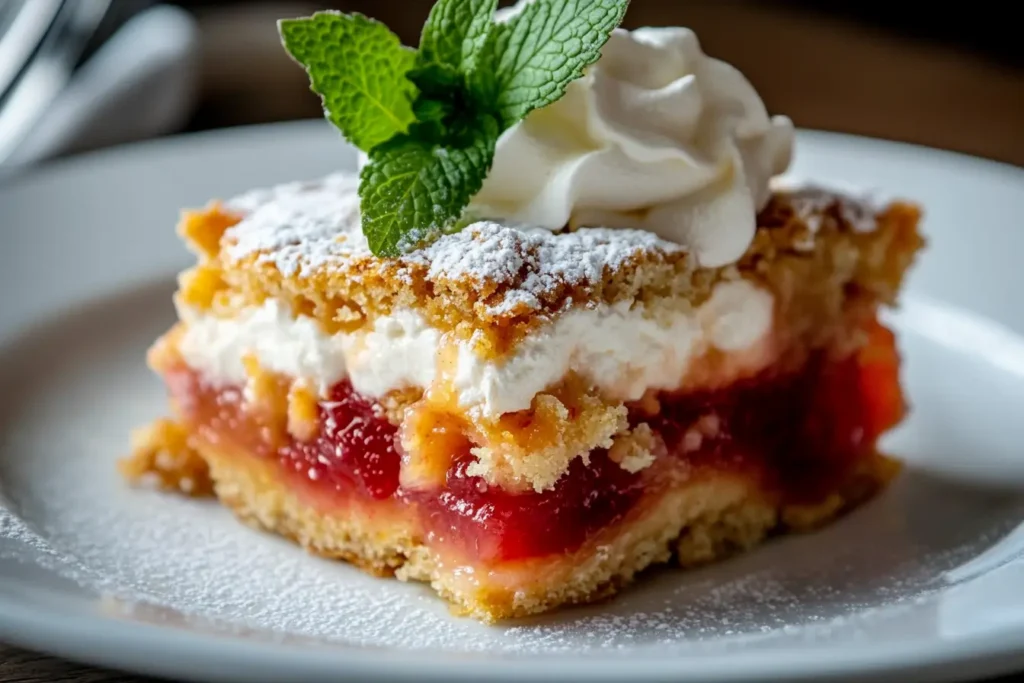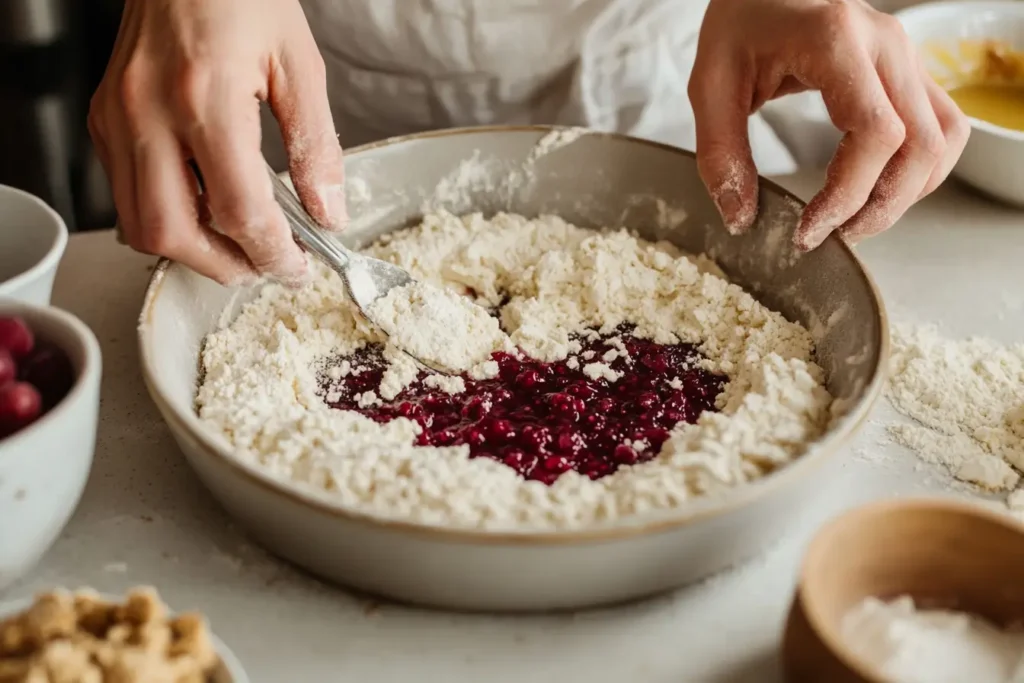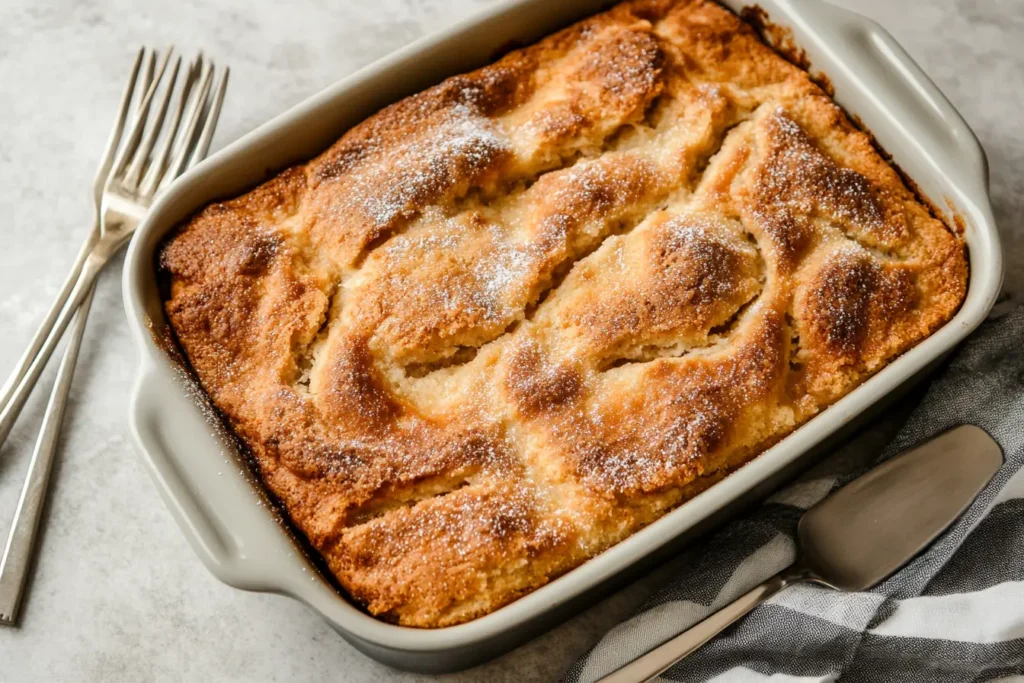Why Is My Dump Cake Still Powdery? Dump cakes are a go-to dessert for their simplicity, but many bakers often wonder: Why is my dump cake still powdery? This common issue can result from uneven layering, insufficient butter, or baking mishaps. In this guide, we’ll explore the possible causes and share foolproof tips to ensure your dump cakes turn out golden-brown and delicious every time.
Table of Contents
Understanding Dump Cake Basics
Dump cakes may sound casual, but getting them right requires understanding their foundations. This part covers what makes a dump cake unique and the crucial roles each ingredient plays in its success.
What Is a Dump Cake?
A dump cake is a dessert where all the ingredients are “dumped” into a baking dish and baked to golden perfection. It’s known for its ease—no mixing bowls, minimal cleanup, and a rustic appeal that’s hard to beat. Despite its simplicity, proper layering and ingredient proportions are key to avoiding baking mishaps.
How Dump Cakes Are Typically Made
The classic dump cake starts with a layer of fruit filling or fresh fruit at the bottom, followed by a dry cake mix sprinkled evenly over the top. Melted butter or another liquid is drizzled over the cake mix to moisten it. This layering technique is meant to create a balance between the soft fruit base and the crunchy, golden topping.
Key Ingredients and Their Roles
- Fruit Filling: Acts as the base, adding moisture and sweetness. Canned fruits or pie fillings are commonly used, but fresh fruit can also work with some adjustments.
- Cake Mix: Provides structure and flavor. Variants like yellow, white, or spice cake mix are popular, but the choice impacts the overall taste.
- Butter or Liquid: Essential for hydrating the dry mix. The amount and distribution of butter are often the culprits behind a powdery topping.
- Optional Toppings: Nuts, coconut, or spices can add texture and flavor, but they need to be applied sparingly to avoid uneven cooking.
Common Reasons for a Powdery Dump Cake
Dump cakes might be simple, but achieving perfection isn’t always foolproof. Several common missteps can leave your dessert with a dry, powdery topping. Let’s explore these pitfalls and how they can be avoided.
Uneven Distribution of Ingredients
One of the top culprits for a powdery dump cake is uneven layering. If the dry cake mix isn’t spread uniformly across the fruit layer, some areas won’t absorb moisture properly. This issue is exacerbated when butter or liquid is poured unevenly, leaving certain sections of the mix completely dry.
- Pro Tip: Use a spatula to spread the dry cake mix evenly before adding butter. This ensures consistent results.
Insufficient Butter or Liquid
Dump cakes rely heavily on butter or other liquids to moisten the dry mix. Skimping on butter or failing to use an adequate substitute often results in patches of unbaked mix.
- Avoid this mistake by sticking to the recommended butter quantity or substituting it with a liquid like milk for extra moistness.
Incorrect Oven Temperature or Baking Time
Even the best-layered dump cake can fail if the oven isn’t properly calibrated. Baking at too low a temperature prevents the butter from fully melting, which is critical for hydrating the cake mix. Similarly, removing the cake too soon often leads to a raw texture.
- Solution: Use an oven thermometer to verify your oven’s temperature, and follow the recipe’s suggested baking time.
Using the Wrong Type of Cake Mix
Not all cake mixes are created equal. Some mixes may require extra liquid due to their unique formulation. Using low-moisture varieties without adjusting other ingredients can cause dryness.
- For best results, stick to tried-and-tested brands that align with dump cake recipes.
For additional baking tips on improving consistency, check out this guide on dump cake mistakes.
How to Fix a Powdery Dump Cake
A powdery dump cake isn’t the end of the world! With a few adjustments, you can salvage your dessert and ensure a flawless finish in the future.
Redistribute the Cake Mix and Butter
If your cake is still powdery after baking, remove it from the oven and redistribute the unbaked areas with a fork. Pour additional melted butter or a splash of milk over the dry spots and bake for a few more minutes.
- This quick fix often restores the cake’s texture and prevents wastage.
Tips for Adding More Liquid or Butter Mid-Bake
Sometimes, you’ll notice the problem halfway through the baking process. Don’t panic! Melted butter or warm liquid (like cream or milk) can be carefully poured over dry areas while the cake is still in the oven.
- Be cautious not to drench the entire cake—target only the problematic sections.
Preventing Powdery Patches Before Baking
The best way to fix a powdery dump cake is to avoid the issue altogether.
- Distribute butter evenly by slicing it into thin pats or using melted butter. Pour it in a zigzag motion to cover as much surface area as possible.
- Spread the cake mix uniformly across the fruit layer to minimize dry spots.
For more creative variations and foolproof techniques, explore this lemon dump cake recipe.
Best Practices for Perfect Dump Cakes

Creating a flawless dump cake requires attention to detail. By following these best practices, you’ll avoid common issues like Why is my dump cake still powdery? and produce a consistently delicious dessert.
Choosing the Right Ingredients
Not all ingredients are created equal. For a perfect dump cake:
- Pick high-quality fruit fillings. Whether canned or fresh, ensure they’re moist enough to create a flavorful base. Low-quality fillings may lead to dryness.
- Select a reliable cake mix. Brands with balanced sugar and moisture levels often yield better results. Experiment with mixes like yellow or white cake to match the flavor profile of your chosen fruit.
Layering Techniques for Even Cooking

Proper layering is crucial for a balanced bake:
- Spread fruit evenly: A smooth, even fruit layer ensures that the cake mix gets uniform moisture.
- Distribute cake mix with care: Avoid clumps or overly thick sections by spreading it evenly across the fruit layer with a spoon or spatula.
- Add butter with precision: Melted butter poured in a zigzag pattern helps cover the dry mix effectively, reducing the risk of powdery patches.
Adjusting Baking Time Based on Ingredients
Different fruit fillings and cake mixes may require slight adjustments in baking time.
- For canned fruit: Stick to the recipe’s suggested bake time but monitor the top for golden browning.
- For fresh fruit: Add 5–10 extra minutes to allow the moisture to permeate the mix.
For creative twists on the classic dump cake, check out this lemon cream cheese dump cake recipe.
Troubleshooting Other Dump Cake Problems

While the powdery topping is one of the most common issues, dump cakes can present other challenges, too. From overly soggy results to cakes that lack balance in flavor, here’s how to troubleshoot and perfect your dessert.
Overly Soggy Dump Cakes
A soggy dump cake can happen for several reasons, often tied to excess liquid in the fruit layer or improper ingredient proportions. When too much moisture accumulates at the bottom, the cake mix may not cook evenly.
- Drain the fruit filling: If using canned fruit, always drain the liquid before layering it in the baking dish. This prevents the bottom layer from becoming excessively watery.
- Balance fresh fruit moisture: When using fresh fruit, consider its natural water content. Fruits like strawberries or peaches release a lot of juice during baking. Sprinkle a tablespoon of cornstarch or flour over the fruit before adding the cake mix.
- Cook a little longer: If your cake is already soggy, bake it for an additional 10–15 minutes. Cover the dish loosely with aluminum foil to prevent the top from over-browning while the extra moisture evaporates.
Burned Tops or Edges
Burned edges or an overly browned top can result from uneven butter distribution or an oven that’s too hot. Here’s how to avoid this problem:
- Use melted butter: Pour melted butter in a consistent zigzag pattern, ensuring it covers the cake mix evenly. Avoid using pats of butter unless they’re sliced thin and distributed uniformly.
- Lower the temperature slightly: If your dump cake tends to burn, lower the oven temperature by 25°F and extend the baking time. This allows for more even cooking without scorching the top.
- Check the oven position: Place the baking dish on the middle rack for even heat distribution.
Cakes That Are Too Sweet or Bland
The balance of flavors in a dump cake is essential. If your cake turns out too sweet, it can overpower the dessert, while a bland cake can be disappointing.
- Adjust sweetness: To tone down sweetness, pair the fruit layer with a tart or neutral ingredient like unsweetened applesauce or fresh lemon juice.
- Enhance flavor: If the cake feels bland, spice it up! A sprinkle of cinnamon, nutmeg, or even a dash of vanilla extract can add depth.
- Try a different mix: Some cake mixes are sweeter than others. Experiment with spice, yellow, or white cake mixes to find the right balance for your taste buds.
Crumbly or Dry Texture
A dump cake that turns out crumbly or dry is often the result of not enough liquid or butter in the recipe. Here’s how to avoid this issue:
- Double-check measurements: Use the amount of butter or liquid specified in the recipe. Skimping on these essential components can lead to dryness.
- Incorporate a moisture boost: Adding a few tablespoons of milk or cream over the cake mix before baking can make a big difference in texture.
Incorporating Creative Fixes
Sometimes, minor adjustments can transform your dump cake. Here are a few creative fixes to common problems:
Serve with accompaniments: Pairing your dump cake with whipped cream, vanilla ice cream, or a drizzle of caramel can enhance its flavor and mask minor imperfections.
Add a topping layer: If your cake feels incomplete, add a quick topping of chopped nuts, shredded coconut, or crushed cookies for extra texture.
For more dump cake tips, visit our website’s recipe section.
FAQs
Dump cakes may seem simple, but even seasoned bakers often have questions about achieving the perfect results. Let’s address some of the most common concerns, including Why is my dump cake still powdery?
How to Make a Lemon Cake Taste More Lemony?
A lemon dump cake can fall flat if the lemon flavor doesn’t shine through. To enhance it:
- Add fresh lemon zest to the fruit layer.
- Use lemon juice instead of water or other liquids.
- Incorporate a lemon-flavored cake mix for an extra citrus kick.
Does Dump Cake Have to Be Refrigerated After Baking?
Yes, if your dump cake contains perishable ingredients like cream cheese or milk-based toppings. Store it in the fridge once cooled to preserve freshness. Cakes without these ingredients can stay at room temperature for up to two days, but refrigeration helps extend their shelf life.
Why Is My Dump Cake Still Powdery?
This common issue arises from uneven butter distribution or insufficient liquid. Make sure to:
- Melt the butter and pour it evenly in a zigzag motion.
- Check the fruit layer for adequate moisture before adding the cake mix.
- Bake the cake for the recommended time, ensuring all dry patches are hydrated and cooked.
How to Know When a Dump Cake Is Done?
A dump cake is ready when the top is golden brown and slightly crisp. The fruit layer should be bubbling around the edges, signaling that the entire dessert is cooked through.
For additional tips on troubleshooting dump cakes, check out our website’s other recipe guides.
Wrapping Up
Dump cakes are a delightful dessert, but even simple recipes can come with challenges. From understanding why your dump cake is still powdery to fixing soggy or overly sweet results, these tips and tricks will help you master the art of this effortless treat.
Remember, success lies in even layering, proper butter distribution, and selecting the right ingredients. Don’t forget to explore creative variations to keep things exciting in the kitchen. With this guide, you’ll avoid the common pitfalls and serve up perfect dump cakes every time.
For more delicious inspiration, visit our recipe section and try your hand at new creations!
Conclusion
Dump cakes are more than just a quick dessert option—they’re a delightful way to combine simplicity with creativity. Yet, as straightforward as they may seem, challenges like a powdery topping or uneven baking can often lead to frustration. By focusing on key techniques and paying attention to small details, you can transform this humble dessert into a show-stopping treat every time.
Why Mastering Dump Cakes Is Worth It
Learning how to troubleshoot issues like Why is my dump cake still powdery? not only saves your dessert but also builds confidence in the kitchen. Dump cakes are versatile and forgiving, making them perfect for last-minute gatherings or experimenting with new flavors. Plus, the minimal prep and cleanup allow you to focus on enjoying the process without stress.
From family-friendly options to crowd-pleasing party desserts, mastering the art of dump cakes gives you a go-to recipe that’s as reliable as it is delicious.
Recap of Key Takeaways
To ensure your dump cakes turn out perfect, remember these essential tips:
- Even Butter Distribution: Melt butter and pour it in a zigzag pattern, covering the entire surface of the dry cake mix. This step is crucial to avoid the dreaded powdery patches.
- Proper Layering: Smooth and even layers of fruit, cake mix, and butter help achieve uniform cooking and flavor balance.
- Adjust Baking Time: Pay attention to your oven’s temperature and consider ingredient adjustments like fresh or canned fruit, which may impact the baking duration.
- Creative Variations: Once you’ve mastered the basics, experiment with different combinations of cake mixes, fruits, and toppings.
By following these strategies, you’ll not only troubleshoot issues like a dry topping but also elevate your dump cake game to new heights.
The Joy of Experimentation
One of the best things about dump cakes is their flexibility. Have leftover canned fruit? Use it! Want to add a crunchy topping? Sprinkle some nuts or shredded coconut before baking. The opportunities to personalize your dessert are endless, which means you’re never stuck with a single recipe.
Experimentation also allows you to troubleshoot more effectively. For instance, if your cake turns out too sweet, adding a tangy element like lemon zest or sour cream can balance the flavors. Similarly, if it’s too dry, try incorporating an extra layer of moisture, such as a drizzle of condensed milk before baking.
From Beginner to Pro
If you’re new to baking, dump cakes are a great place to start. They’re virtually foolproof as long as you follow the basic principles outlined in this guide. As you grow more comfortable, you can experiment with advanced techniques, like creating themed dump cakes for holidays or using seasonal fruits for unique twists.
Even seasoned bakers can find joy in perfecting dump cakes. Despite their simplicity, small adjustments can significantly impact the final result, allowing you to refine your skills and explore new culinary possibilities.
A Dessert for Every Occasion
Whether you’re hosting a dinner party, contributing to a potluck, or simply craving something sweet, dump cakes offer a hassle-free solution. Their versatility means you can adapt them to suit any occasion, and their quick preparation makes them ideal for busy schedules.
Dump cakes are also great for involving kids in the kitchen. The simple “dump and bake” process is fun and educational, helping young bakers develop confidence while creating something tasty.
By addressing issues like Why is my dump cake still powdery? and embracing creative possibilities, you’ll unlock the full potential of this beloved dessert. Remember, baking is as much about enjoying the process as it is about the result. With a little patience and practice, you’ll soon be making dump cakes that are not only reliable but also irresistibly delicious.
For more inspiration and expert tips, don’t forget to explore our recipe collection and discover even more ways to make your baking shine!
Dernière mise à jour : 15 February 2025

